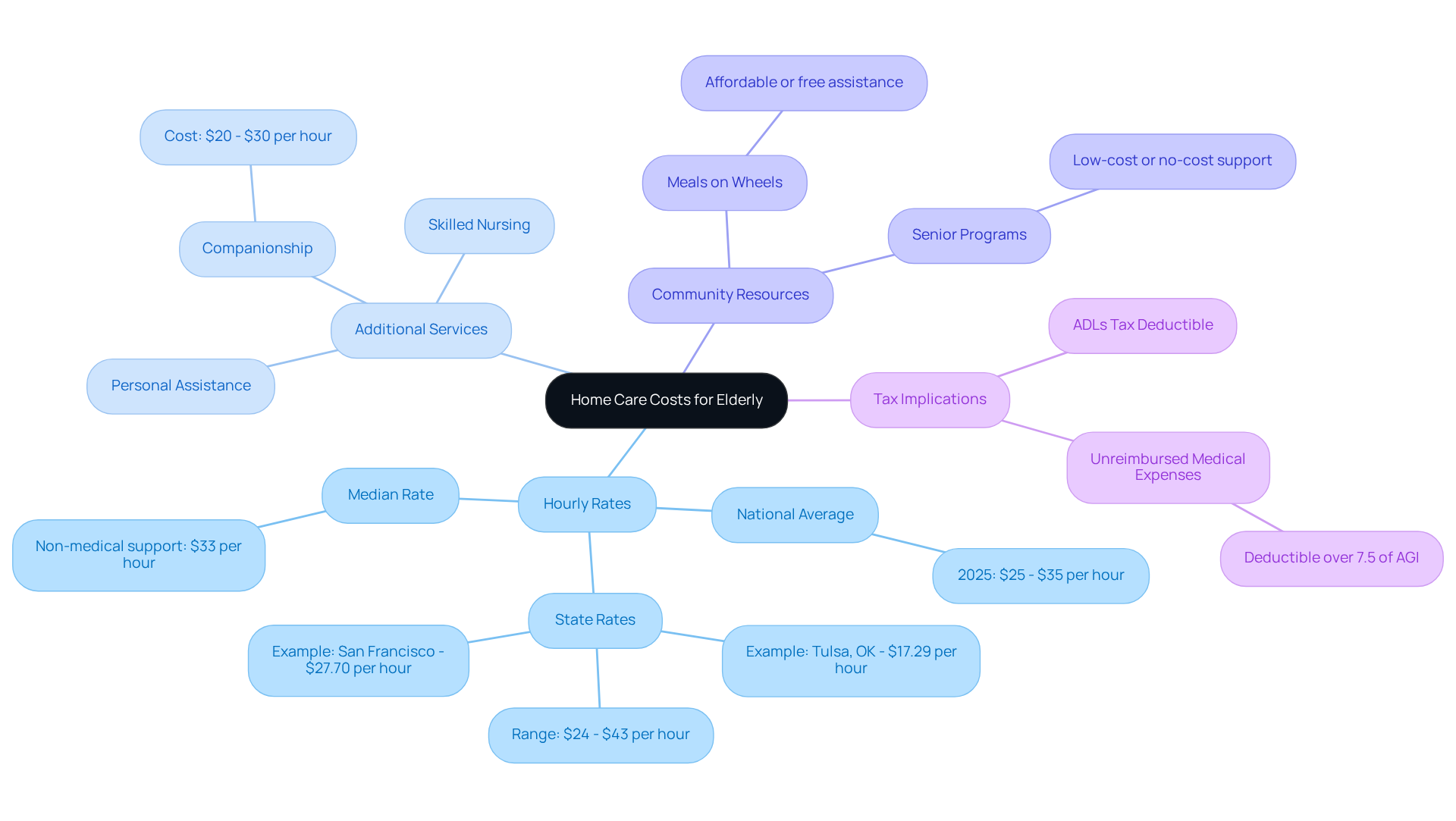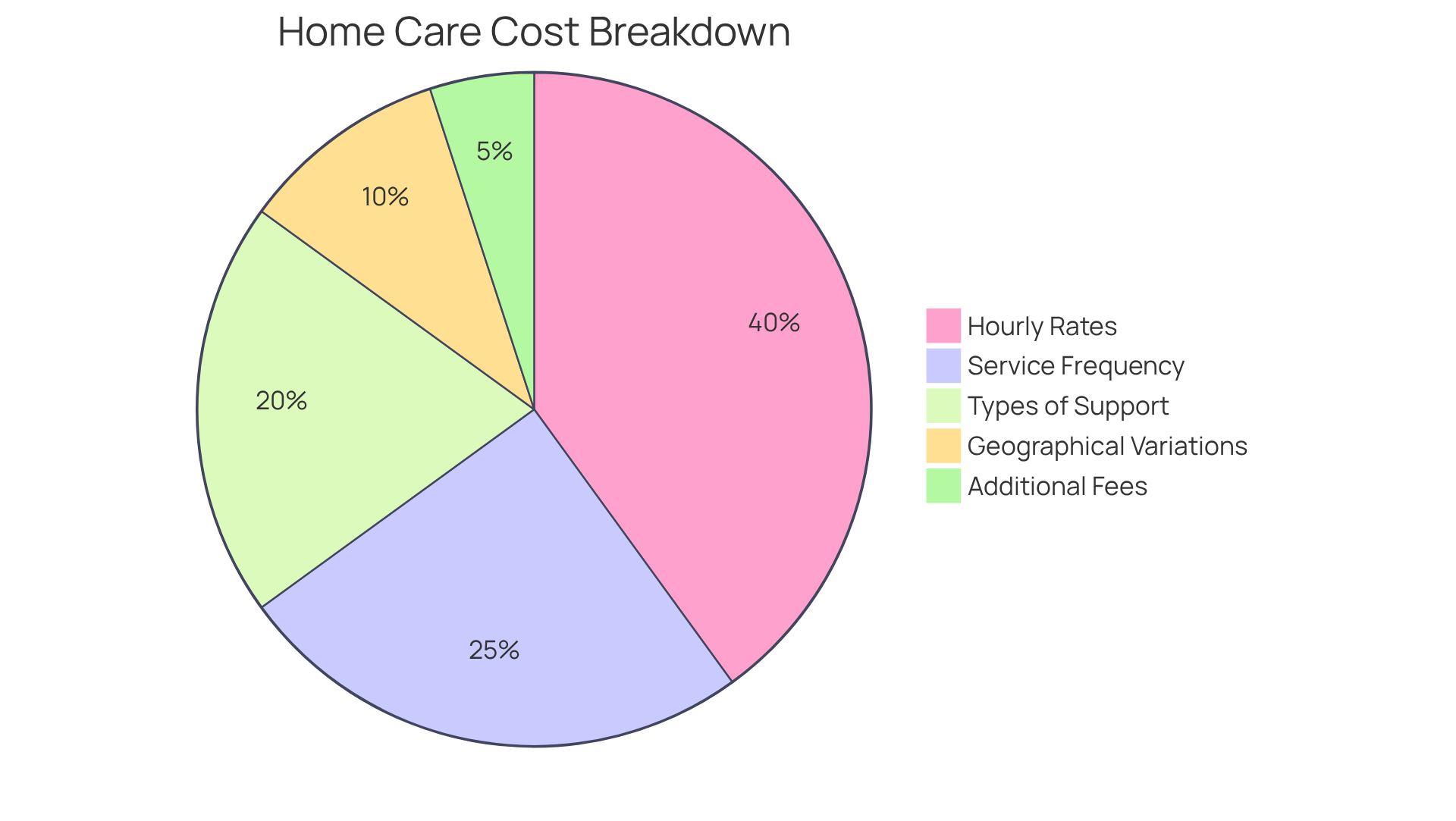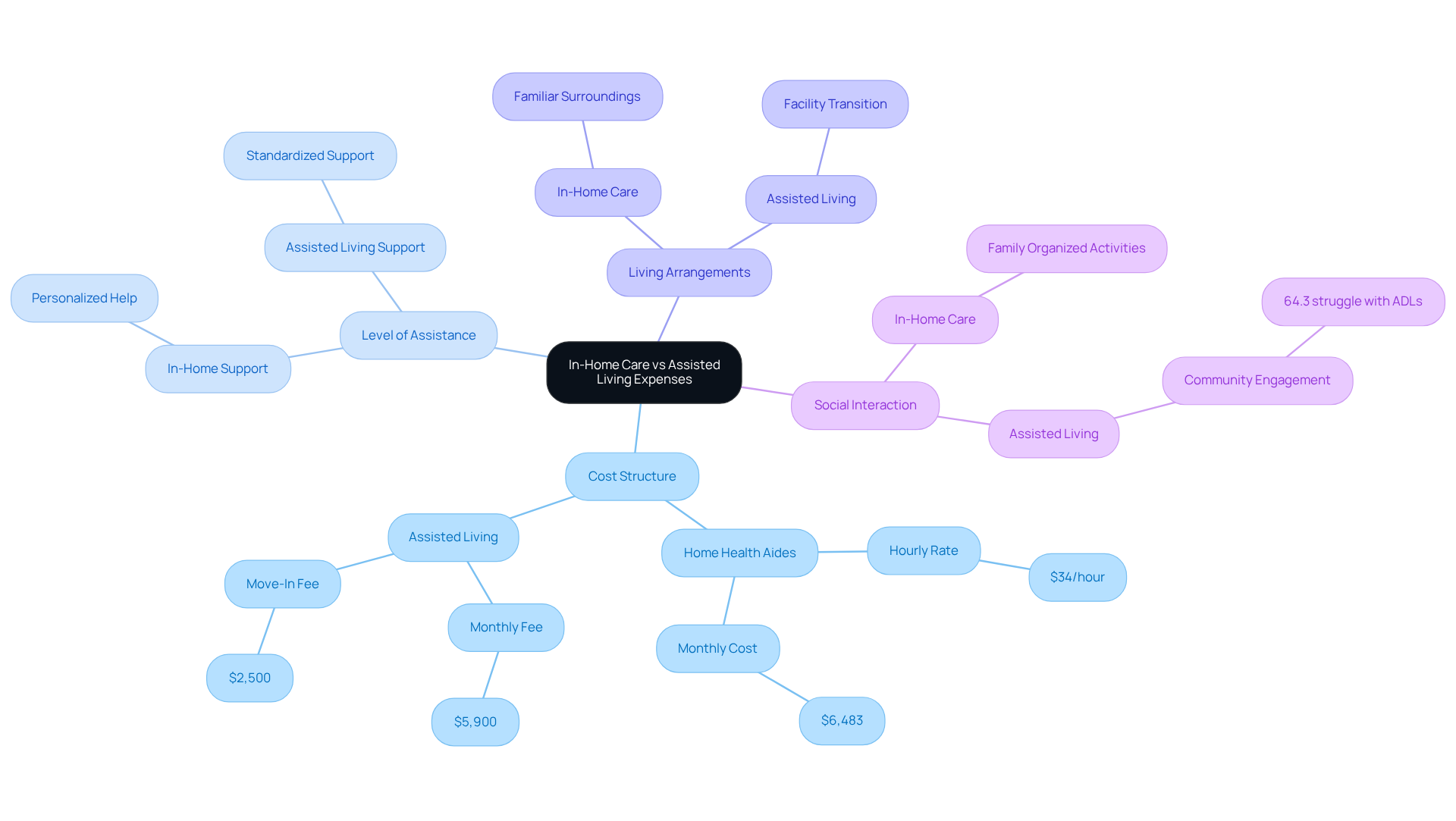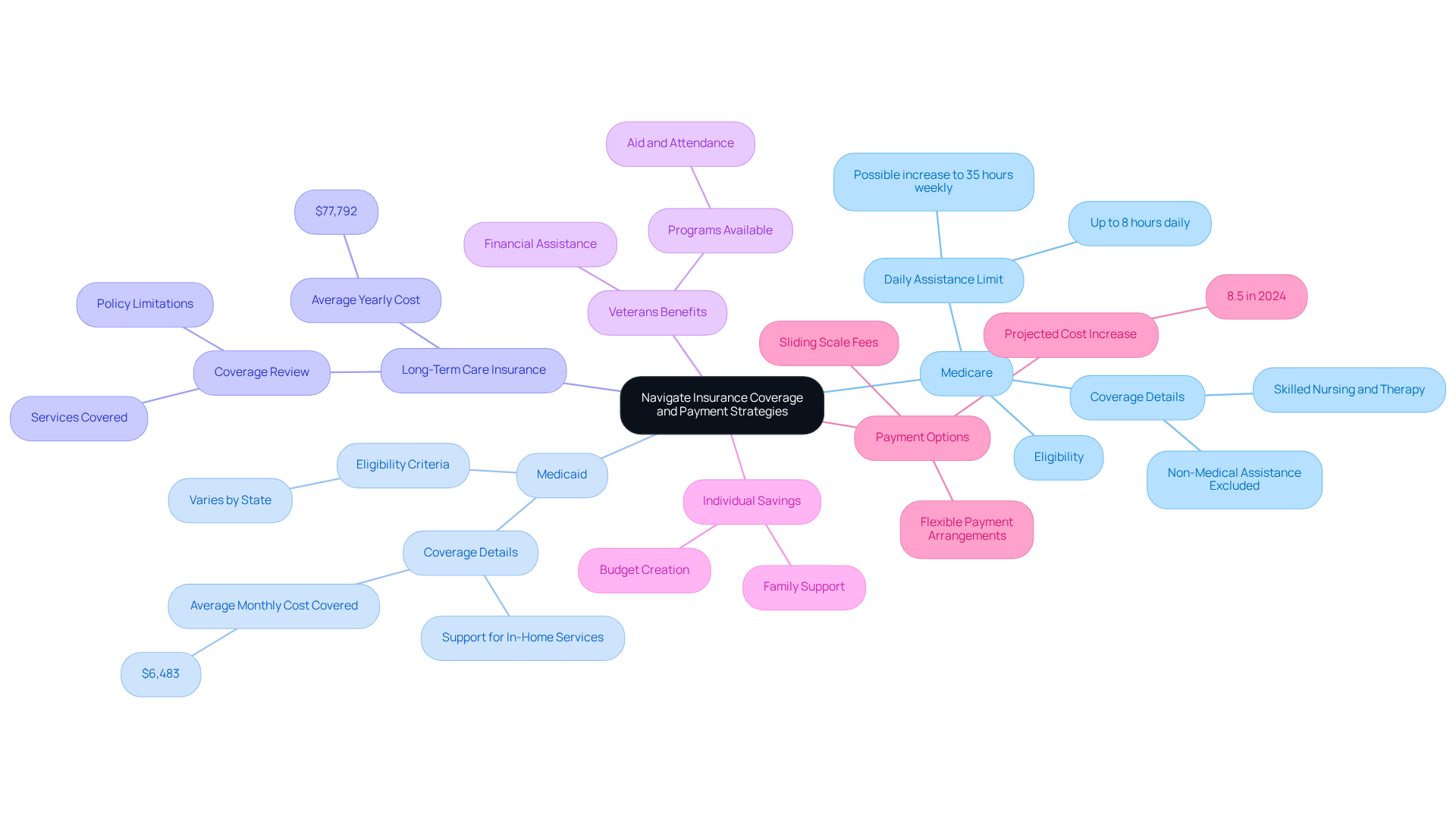Introduction
Navigating the financial landscape of home care for the elderly can feel overwhelming for families. It’s a complex decision, filled with emotional challenges. Costs can vary widely based on location, type of care, and frequency of services, making budgeting for a loved one’s needs a daunting task. As average hourly rates for in-home assistance are expected to rise, families often wonder: how can they find the most suitable and affordable care options without sacrificing quality?
This article aims to shed light on the intricacies of home care costs. We’ll explore valuable insights and strategies to help families make informed decisions, ensuring that their loved ones receive the compassionate care they deserve. Remember, you’re not alone in this journey; together, we can navigate these challenges with understanding and support.
Explore the Basics of Home Care Costs
The home care cost for elderly individuals can vary widely, influenced by factors like the type of support needed, service frequency, and geographical location. In 2025, the national average cost for in-home assistance ranges from $25 to $35 per hour, with the median rate for nonmedical support hovering around $33. State rates can fluctuate between $24 and $43 per hour. Understanding these basics helps families anticipate potential home care costs for the elderly and budget accordingly.
It’s important to consider not just the hourly rates but also the total monthly expenses, as the home care cost for elderly can accumulate quickly based on the level of assistance required. Families might find themselves needing to budget for additional services like companionship, personal assistance, or skilled nursing, each with its own pricing structure.
Recent trends indicate that 64% of home assistance agencies are concerned about rising costs, reflecting broader economic challenges that could impact pricing. However, there are community services, such as Meals on Wheels, that offer affordable or even free assistance for seniors, providing families with alternative options to manage expenses effectively.
Additionally, families should be aware that help with activities of daily living (ADLs) may be tax-deductible, potentially offering some financial relief. Understanding the implications of the 80/20 Provision within the Medicaid Access Rule is also crucial, as it affects how funding is allocated for support services, influencing overall expenses for families planning for home assistance.
Navigating these financial waters can feel overwhelming, but remember, you’re not alone. There are resources and support systems in place to help you through this journey.
Analyze Key Cost Components of In-Home Care
Home care cost for elderly can feel overwhelming, but breaking them down into key components can help families navigate this journey with more clarity and confidence.
-
Hourly rates: Understanding the home care cost for elderly individuals is crucial. Companion assistance typically ranges from $20 to $30 per hour, while skilled nursing services can be priced between $50 and $80. In 2025, the national median expense for non-medical home assistance is estimated at $33 per hour, with state rates varying from $24 to $43. Knowing these rates helps families choose the right level of support based on the home care cost for elderly individuals.
-
Service Frequency: It’s important to consider how often support is needed each week. For instance, part-time assistance (like 20 hours a week) is generally more affordable than full-time or round-the-clock care. Monthly expenses can vary significantly based on the frequency of assistance, with estimates suggesting that the home care cost for elderly receiving 30 hours of help a week could be around $4,290.
-
Different types of support have varying home care costs for elderly individuals. Personal support services, which help with daily tasks like bathing and dressing, usually cost more than companionship services. For example, personal support assistance typically ranges from $25 to $40 per hour, reflecting the higher level of care provided.
-
Geographical Variations: Location plays a big role in costs. Urban areas often have higher rates compared to rural regions. Some states offer in-home care rates as low as $21 per hour, while others, like Alaska, can reach $35 to $45 per hour due to higher living expenses. Interestingly, Louisiana and Mississippi boast the lowest costs in the U.S.
-
Additional Fees: Be aware that some agencies may charge extra for specialized services, travel fees, or administrative costs. It’s wise for families to inquire about these potential additional charges to create a comprehensive budget for the home care cost for elderly assistance. As home assistance expert Vicki Demirozu wisely notes, “Beginning home support early can aid seniors in aging in place longer and prevent problems such as social isolation and inadequate nutrition.”
By understanding these elements, families can better manage the home care cost for elderly when it comes to in-home assistance. This knowledge empowers them to choose services that meet their loved ones’ needs while staying within budget, ensuring a supportive and caring environment.
Compare In-Home Care and Assisted Living Expenses
When families explore support alternatives, they often find themselves weighing the home care cost for elderly against those of assisted living centers. It’s a tough decision, and understanding the differences can help ease some of that burden. Here are some essential comparisons to consider:
-
Cost Structure: In-home care typically charges on an hourly basis, with the national median cost for home health aides around $34 per hour. On the flip side, assisted living facilities usually have a fixed monthly fee. In 2024, the average monthly expense for assisted living is about $5,900, which shows a significant increase from previous years. The home care cost for elderly individuals includes an average of around $6,292 monthly for homemaker services, while home health aides average about $6,483.
-
Level of Assistance: In-home support offers personalized help tailored to individual needs, creating a more adaptable caregiving experience. In contrast, assisted living facilities often provide a more standardized level of support, which might not meet the unique requirements of every senior.
-
Living Arrangements: One of the greatest advantages of in-home assistance is that it allows seniors to remain in their familiar surroundings. This can greatly enhance their comfort and overall well-being. Assisted living, however, requires a transition to a facility, which can be a daunting adjustment for many.
-
Social Interaction: Assisted living facilities often provide numerous opportunities for social engagement and activities, which can be vital for seniors’ mental and emotional health. Notably, 64.3% of residents in these facilities struggle with at least one activity of daily living, highlighting the importance of social interaction. In-home support may place the onus on families to organize social activities, which can sometimes lead to feelings of isolation if not managed well.
Overall costs must be taken into account by families assessing in-home assistance, as the home care cost for elderly includes housing, meals, and other living expenses related to assisted living. It’s also important to be aware of potential additional fees beyond basic room and board in assisted living facilities. This comprehensive perspective is crucial for families to make informed decisions based on their financial situations and specific support needs.
Understanding these factors can empower families to choose the best assistance option for their loved ones, balancing financial implications with the desired level of support and comfort.
Navigate Insurance Coverage and Payment Strategies
Navigating the financial landscape of home care cost for elderly can be overwhelming. It’s important to understand insurance coverage and payment strategies to help ease that burden:
-
Medicare: Medicare covers specific home health services, like skilled nursing and therapy, but often leaves out non-medical in-home assistance. Families should check eligibility and specific coverage details. Typically, Medicare allows for up to 8 hours of home health assistance daily, with the possibility of increasing to 35 hours weekly if requested.
-
Medicaid: For those with limited income, Medicaid can provide support for in-home services. Eligibility criteria can vary widely by state, so it’s crucial for families to consult local resources for tailored information. In some states, Medicaid can cover a significant portion of the home care cost for elderly individuals, averaging around $6,483 monthly across the United States.
-
Long-Term Care Insurance: This type of insurance can help reduce the costs associated with in-home assistance. Families should carefully review their policies to understand what services are covered and any limitations. The average yearly home care cost for elderly individuals needing a home health aide is about $77,792.
-
Veterans Benefits: Veterans may qualify for benefits that assist with home support expenses. Programs like Aid and Attendance offer financial help for eligible veterans and their partners, alleviating some of the financial pressures linked to in-home care.
-
Individual Savings and Relatives’ Assistance: Many families rely on personal savings or support from relatives to manage expenses. Creating a budget and discussing financial responsibilities can help control the home care cost for elderly effectively, especially since assisted living facilities can require around $70,800 each year.
-
Payment Options: Some caregiving agencies offer flexible payment arrangements or sliding scale fees based on income, making assistance more accessible for families. This approach can be particularly beneficial given the rising home care cost for elderly, which are expected to increase by as much as 8.5% in 2024.
By exploring these options, families can create a comprehensive financial strategy that aligns with their care needs and budget. Remember, you’re not alone in this journey; support is available.
Conclusion
Understanding the costs associated with home care for the elderly is crucial for families navigating this complex landscape. These expenses can vary significantly based on factors like the type of care needed, frequency of service, and geographical location. By grasping these concepts, families can prepare for the financial implications of in-home support and make informed decisions that prioritize their loved ones’ well-being.
Throughout this article, we’ve shared key insights regarding the breakdown of home care costs. We’ve discussed various components, from hourly rates for different types of assistance to the importance of service frequency and geographical variations. The comparison between in-home care and assisted living expenses highlights the need for families to assess their unique situations, considering both financial and emotional factors when choosing the best care option.
In light of these insights, families are encouraged to take proactive steps in planning for home care expenses. Whether exploring insurance coverage options, leveraging community resources, or discussing financial strategies with relatives, it’s crucial to approach this journey with clarity and support. Remember, understanding home care costs empowers families to ensure that their loved ones receive the care they deserve while maintaining financial stability.
Frequently Asked Questions
What factors influence the cost of home care for the elderly?
The cost of home care for elderly individuals can vary based on the type of support needed, service frequency, and geographical location.
What is the national average cost for in-home assistance in 2025?
In 2025, the national average cost for in-home assistance ranges from $25 to $35 per hour, with the median rate for nonmedical support around $33.
How much do state rates for home care vary?
State rates for home care can fluctuate between $24 and $43 per hour.
Why is it important to consider total monthly expenses for home care?
It is important to consider total monthly expenses because home care costs can accumulate quickly based on the level of assistance required, leading to significant financial implications for families.
What additional services might families need to budget for?
Families might need to budget for additional services such as companionship, personal assistance, or skilled nursing, each of which has its own pricing structure.
What recent trend has been observed among home assistance agencies regarding costs?
Recent trends indicate that 64% of home assistance agencies are concerned about rising costs, reflecting broader economic challenges that could impact pricing.
Are there affordable options for home care assistance?
Yes, there are community services, such as Meals on Wheels, that offer affordable or even free assistance for seniors, providing alternative options for families to manage expenses.
Can help with activities of daily living (ADLs) be tax-deductible?
Yes, help with activities of daily living (ADLs) may be tax-deductible, potentially offering some financial relief for families.
What is the 80/20 Provision within the Medicaid Access Rule?
The 80/20 Provision within the Medicaid Access Rule affects how funding is allocated for support services, influencing overall expenses for families planning for home assistance.
What resources are available for families navigating home care costs?
There are resources and support systems in place to help families navigate the financial aspects of home care, providing assistance throughout the journey.





